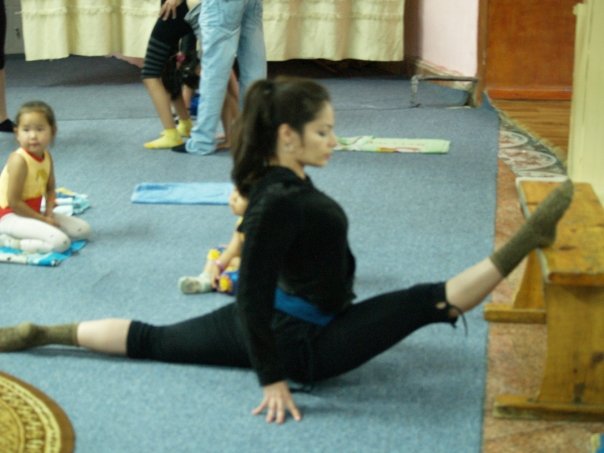- Fit & Bendy Flexibility Fitness
- Pages
- What is Mobility Training?

The Myth: flexibility is only for the gifted few
Flexibility is not only for the young and able-bodied, or limited by gender or size.
Flexibility is not a trait, it’s a skill. A skill that anyone can develop.
I know because I’ve seen that skill grow in thousands of my students, the way it grew for me.

This is me in Mongolia in 2009, four years into my training
Hi, I'm Kristina, the founder and head coach at Fit & Bendy!
When I showed up at Circus Center for my first contortion class I was 30 and had been struggling with chronic pain and disability for 7 years. I was a terrible candidate for circus stardom, but I was obsessed. Thankfully I found an amazing coach, Serchmaa Byamba, who gave me a chance.
And I showed up, and I worked, and I learned. And I got bendier!
I learned that you only need two things to gain flexibility
Quality tools and techniques
Consistent practice over time
If your flexibility is suffering, it is for sure because one or both of these ingredients is not in the cake.
What are Quality Tools and Techniques?
Flexibility is the dark art of the fitness world. Most accreditation programs spend very little time explaining stretching. Even in the world of sports science, flexibility gets little study and attention.
As a result, many people don’t know where to start.
Mostly, when people think of stretching they think of old-school gym class “relax into the stretch” techniques. This is called passive static stretching and it’s a good technique, but it is limited. Passive static stretching alone probably wont get you where you want to go. You need more tools.
A training program that effectively builds healthy, useable flexibility requires a whole toolbox of techniques:
Active
Passive
Resistance
Dynamic
Ballistic
Neurokinetic
Using the whole toolbox doesn’t just build flexibility, it builds mobility.
Flexibility vs Mobility
When people say they want to more flexibility, most of the time they really want more mobility.
Flexibility = the full range that your joint can move when pushed by an outside force
Mobility = flexibility + strength + control (the full range that your joint can move using your own muscles)
You don’t just want flexibility. You want flexibility that you can use. Stretching with a full toolbox builds a body that is resistant to injury and able to move with ease.
What is Consistent Training?
There are no cheats or hacks with flexibility. Any program that promises you flat splits in one month at only 8 minutes a day is lying.
To increase our flexibility we must change the way our body perceives itself. We aren’t just lengthening our muscles and connective tissue. We are reprogramming our nervous system.

The nervous system is a key part of flexibility training
To keep us safe, our nervous system stops us from using our full range of movement.
When we want to increase our range, we need to make that nervous system less nervous. This only happens with consistent work over a period of time.
How long? It depends on your particular nervous system, your consistency, and the quality of your training time (hint: scrolling on TikTok while stretching is poor quality training time).
If you are training at least three or four times a week you will progress more quickly. If you only train once or twice a week you will still see changes, it will just be slower.
This means you have to keep coming back to it, through the ups and downs, good days and bad. And this is where so many flexibility dreams wither and die. If you are too impatient to get to your goal then usually one of two things happens:
You don’t reach your goal fast enough, get frustrated, and give up
You push too hard and get injured
Either way, you don’t reach your goal.
Of the thousands of folks I’ve worked with over the years who reach, even exceed their goals all have one thing in common: they fall in love with the process. That’s what keeps them coming back.

What keeps us coming back? Have a map!
A map into the unknown reaches of flexibility comes in the form of a well designed workout plan.
The hardest thing about training is getting started. Putting on your stretchy pants, clearing that space in your calendar and your living room, getting the dog/cat/kids/cobwebs off your mat, and getting in gear.
So to make that process easier you need to lower the barrier to entry.
I view all of my workouts as little rituals. Whether I’m working on flexibility, lifting weights, or going for a run I always have a plan in place ahead of time. There are three huge advantages to the ritual:
I don’t have to spend any extra energy trying to figure out what I’m going to do
I get that delicious dopamine every time I check one of my training items off the list!
By following the plan I’m able to give my body the consistent work it needs
A good flexibility fitness plan...
uses the full toolbox
challenges your body just enough to inspire growth but not so much that it creates damage
is enjoyable enough that you look forward to doing it.
focuses on the areas where you most want to see progress, but also have days that incorporate full body work to stay balanced.
works with your schedule so you can get your workouts in without stress.
Want help building your flexibility fitness and mobility training plan?
Fit & Bendy offers a variety of online training options including targeted courses and membership in our video library that contains every workout we’ve put online.
You can also find a load of free resources on our YouTube channel.
And you can subscribe to our newsletter for weekly flexibility tips, research, personal stories, and Q&As.
Happy Bendings,
Kristina